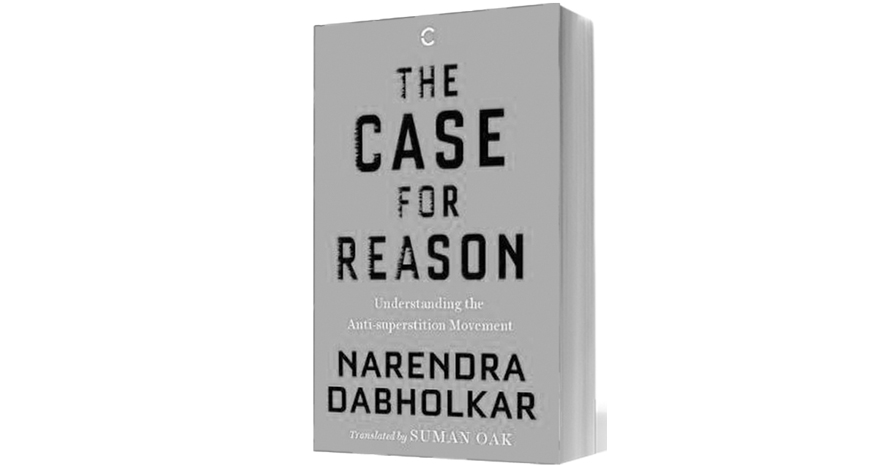‘The Case for Reason’
(Understanding the Anti-superstition Movement)
by Dr. Narendra Dabholkar
Translated by Suman Oak
Publisher: Westland Publications Private Limited , 61, 2nd Floor, Silverline Building, Alapakkam Main Road, Maduravoyal, Chennai – 95.
Narendra Dabholkar’s ‘The Case for Reason’ is a work that gives a detailed account of the work undertaken by his anti superstition movement. The first part of the work, which goes into the theoretical bases that account for superstitions, is quite comprehensive, touching upon all those factors which are either mistaken in themselves or lend themselves to be easily misunderstood.
The work opens with a deceptively simple definition of scientific outlook, which is nothing but ‘understanding the cause – effect relationship of any or examining the cause effect relationship between two incidents’. This tendency, rues the author, has not developed in India even while science and technology is being used in our everyday life on a very large scale. Rational analysis, avers Dabholkar, will prevent a person from drawing wrong inferences in a given situation. Giving a detailed account of how all our cherished ethical values can be created by scientific thinking, he analyses the ingrained reasons for scientific outlook not having taken roots in our country.
Dabholkar deals with the factors in our society which lead to superstition, needless fear and anxiety and mental depression, one after another. Astrology, which claims to predict the future of individuals on the basis of the movement of the planets, “binds people with the chain of fatalistic thoughts,” and our responsibility is to fight it firmly. The chapter on ‘Pseudoscience’ is painstakingly written, the author describing in detail how it differs from science. Many people even in scientifically advanced countries are taken in by such claims like acupuncture, magnetic therapy, telepathy and a host of other phenomena which have no scientific basis. All the same, the author admits with his open mindedness, there are a few things that could be investigated more thoroughly. Another phenomenon that receives comprehensive treatment from the author is hypnosis, which many believe has got scientific roots. He goes on to deal with various facts of blackmagic, ghosts and miracles in all their aspects, why they are easily believed by people and how the practitioners take people for a ride.
Dabholkar poses the question, Does MANS oppose only the Hindu religion, and says that it is against all superstitions of all religions and substantiates his answer. His quote from V.D. Savarkar is interesting since it decries shruti, smriti and the puranas and exhorts the society to put its faith in science and modernity.
Often Dabholkar’s society is being accused of not raising any finger against Brahmin rituals, because he is a Brahmin by birth he says in his preface. This, he maintains, is far from truth since the members of his society are drawn from all castes, and have meticulously refrained from supporting any caste or singling out any particular caste for censure.
The author then goes on to cite the case histories in which he exposed charlatans. The one in which he cornered a miracle making Narendra Maharaj with a book published by the godman’s own trust in public in front of witnesses chosen by both the sides and how the ‘Maharaj’ was exposed is narrated in detail. The episode was publicized to the enlightenment of the public.
Dabholkar’s letter to Pope John Paul II on his declaration of sainthood on Mother Teresa is a model of objectivity and fair-mindedness, because he does not question the granting of sainthood to her but only the search for miracles performed by her.
The case of schoolgirls playing pranks by putting small stones into their eyelids and presenting it to the teacher as an instance of black magic until Dabholkar and his selected team approached the matter with understanding and compassion and revealed that there was no blackmagic involved is worth reading since it throws light on child psychology and on bringing up children.
He has devoted a chapter on how uncharitably he is targeted by the so called defenders of religion who keep calling him a heretic out to destroy their cherished Hindu tradition. Often partisan newspapers take sides with these hate mongers and publish distorted news, even blacking out the balanced statements made by him. There has also been an allegation that he was sullying Hinduism at the instance of Christian missionaries.
The chapter gives an elaborate account of a number of the activities undertaken by his organization and the positive impact it has had on the society despite constant mudslinging by vested interests.
In the last paragraph of his book he sums up the activities of his association and seems to be happy at it. He is also sure that he has never tried to deliberately hurt anyone’s mind or heart. But his opponents are upset with him since he has demolished their citadel of ritualism and ceremonial religion. It is because “the eradication of superstitions is not acceptable to the majority of people.” The task undertaken makes the individual feel forlorn and friendless. Yet, he affirms the individual member ‘works to ensure that his inadequacies and weaknesses do not affect the organization.’
He concludes his work by inviting feedback from readers. It is deplorable that such a sensitive and understanding person interested in improving the lot of fellow human beings by making their vision wider had his life cut short by a bigot’s bullets.
– Leslie Amarson





